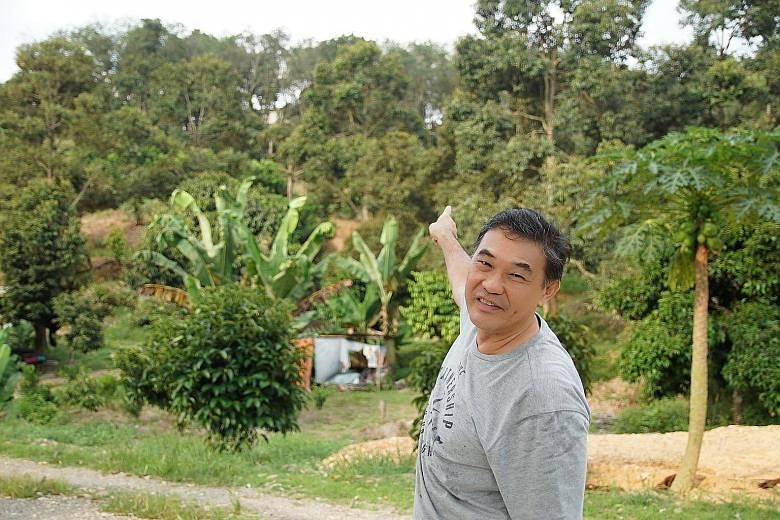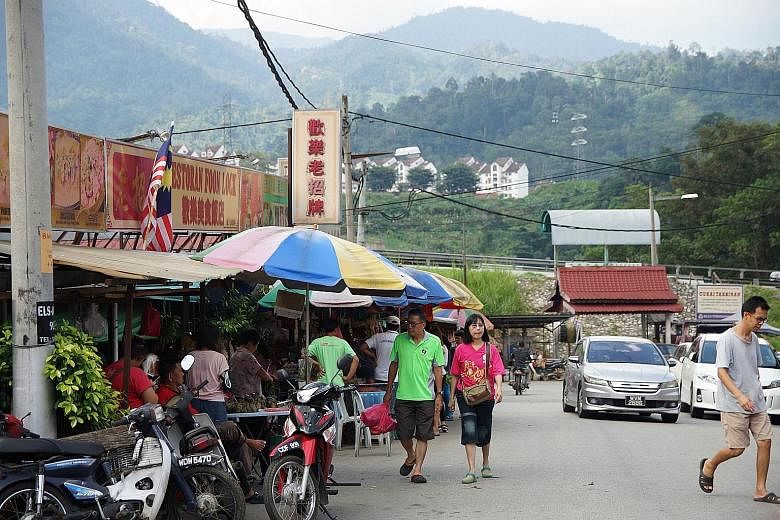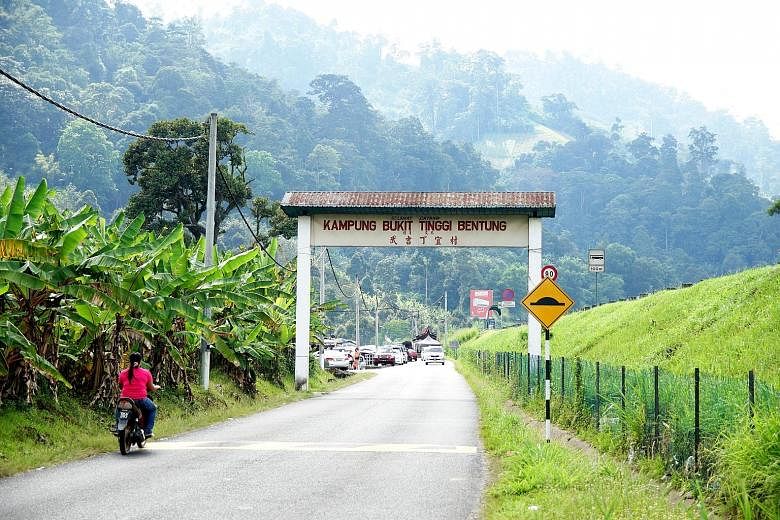Tucked below Genting Highlands, Malaysia's most visited tourist destination, is a small, nondescript village that is expected to benefit from the feel-good Budget 2018 unveiled by Prime Minister Najib Razak last week.
All but forgotten by younger Malaysians, Bukit Tinggi is one of the Chinese "New Villages" that helped Malaysia overcome a Communist uprising some 60 years ago.
Now, the Malaysian government is hoping to turn it - and a select handful of other New Villages - into tourist magnets for those seeking eco-tourism adventures and local produce such as durians.
"For the development of Chinese New Villages, a RM65 million (S$21 million) allocation will be set aside, with an additional RM10 million for house repair programmes," Datuk Seri Najib said at the Budget reading on Oct 27.
While the government already channels funds to the New Villages annually for infrastructure upgrades, from July this year, some of these funds will be targeted at 20 select villages as part of a pilot programme to invigorate them as tourist destinations.
For residents of Bukit Tinggi, development could not come sooner. The village next to a highway in Pahang appears to have remained unchanged for the last 20 years, save for the addition of a large Chinese restaurant to an already crowded row of eateries.
The unassuming place with some two dozen restaurants is known to travellers as a pit stop for meals on the way up to Genting Highlands or other nearby hilltop resorts, such as Berjaya Hills and Janda Baik.
COLONIAL LEGACY
The Chinese New Villages are a legacy of the British colonialists during the Communist insurgency in the 1950s.
Concerned that rural Chinese communities living at the edge of jungles would support or be forced to support the Communist guerillas with food and provisions, the British herded the villagers into housing compounds ringed with barbed wire and guarded by watchtowers. In return, the residents of these 450 New Villages received access to water, electricity and education. The plan worked as it starved the guerillas of support.
Over half a century later, the number of New Villages has risen to 613. But many are in a state of decline as young people migrate to cities to look for jobs.
Today, the government hopes to rejuvenate these areas, some of which are famous for their agricultural produce. Bukit Tinggi, for example, nestled in a valley between mountains and hills that form the central spine of Peninsular Malaysia, is known for its extra spicy "Bentong ginger".
The variety is cultivated on Bukit Tinggi's highlands but sold in the nearby town of Bentong, thus earning it its name. As yet, however, there has been no cohesive effort to brand and market Bukit Tinggi's top product, or to spin off tourism opportunities from it.
"Bentong is famous for ginger. But do you see anyone selling ginger tea or offering cuisine made from Bentong ginger in eateries?" said durian orchard owner Jimmy Loke, 57, from Bentong district.
"We need a holistic solution. But no one is doing it."
The government budget for the New Villages this year is RM40 million, with RM2 million already spent on the villages in the pilot programme since July. The money has largely gone towards upgrading infrastructure like parking lots, tourist signboards and roads.
But small business owners argue that they have not received any assistance from the government.
The dozen or so Bukit Tinggi villagers that The Straits Times spoke to said they were unaware of the programme to promote and develop New Villages.
Help is available, insisted New Village division director Wee Li Ling.
She told ST that funding will be channelled based on the merits of the village's proposal.
"On the ground, the village head and committee members are the ones who know what are the problems and come to us to let us know what they need," said Ms Wee.
-
QUICK FACTS
-
• The New Villages were formed in the 1950s by British colonialists to combat largely ethnic Chinese Communist guerillas.
• Chinese communities living near jungles and in remote areas were moved to fenced compounds with watchtowers, effectively cutting off support for the Communists.
• The resettlement saw half a million Chinese relocated to guarded hamlets in less than a decade.
• These New Villages gave rural Chinese access to water, electricity and education, forming part of the British strategy to win over the hearts of settlers.
• A total of 450 New Villages existed after Malaysia's independence in 1957. There are 613 today.
• In July, the government announced a plan to market New Villages as tourist destinations. Twenty villages in the states of Johor, Perak, Pahang, Melaka, Selangor, Negeri Sembilan and Kedah were selected for the pilot programme .
• The government has allocated RM300 million (S$96.4 million) for the New Villages from 2016 to 2020. Most of the funds are for infrastructure improvements, such as roads, drainage, parking spaces and signboards. RM40 million is to be spent this year, and RM75 million next year.
Trinna Leong
According to Minister in the Prime Minister's Department Wee Ka Siong, the government has asked local newspapers to write features on each of the selected New Villages. These will be compiled into a coffee table book to be shared with foreign delegations and as promotional material.
Funds and publicity notwithstanding, the villages' revival will also require social media-savvy entrepreneurs with ideas for new businesses in agro-and eco-tourism, and the capability to run them.
With Kuala Lumpur just an hour's drive away, however, it will be a challenge enticing young Malaysians to return or move to a quiet enclave like Bukit Tinggi or its closest town Bentong.
Still, there are hopeful signs that the trickle of tourist dollars could turn into a larger flow, thanks to the king of fruits. There is a new buzz around durian plantations as tourists from China are willing to pay high prices for the fruit - up to RM100 a kilogram for the Musang King variety.
Durian festivals have become the new rage, and the government wants to keep the interest growing.
Both Bukit Tinggi and Bentong lie within the Bentong electoral constituency of Transport Minister Liow Tiong Lai, who pins high hopes on the area's produce.
"I hope our famous Musang King durian and Bentong ginger will attract more visitors, especially those from China," he said in July, as he played tour guide to yet another group of Chinese visitors.




